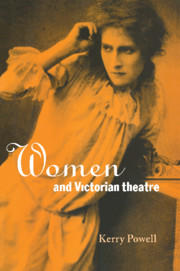2 - Masculine panic and the panthers of the stage
Published online by Cambridge University Press: 06 November 2009
Summary
Rachel was the panther of the stage…she had little tenderness, no womanly caressing softness.
(G. H. Lewes, On Actors and the Art of Acting, 1875)What have we to do with homes, and firesides? Have we not the theatre, its triumphs, and full-handed thunders of applause? Who looks for hearts beneath the masks we wear?
(Peg Woffington on actresses, Masks and Faces, 1854)Victorian men, including the male coterie of drama critics, reacted with anxiety as well as admiration when they beheld displays of female control on stage. Captivated by the power of an exceptional actress, they experienced under her influence a sense of danger to themselves and an apprehension – often frankly expressed, sometimes covertly – that social codes of gender were being challenged before their eyes. Could women so commanding be women at all? Could their multiple assumed identities be reconciled with the narrow domesticity which ordinarily defined femininity? In exceeding the limits of what was thought proper to woman's nature, could actresses be considered healthy specimens of their gender in either a physical or mental sense? From such misgivings the Victorians constructed a rhetoric of the actress which functioned to monitor and control her excesses even as it allowed a space for her intimidating performances.
G. H. Lewes, for example, writes most confidently of the actress famed for her pathos-charged enactments of Phedre when he metaphorizes her in nonhuman terms.
- Type
- Chapter
- Information
- Women and Victorian Theatre , pp. 13 - 63Publisher: Cambridge University PressPrint publication year: 1997



